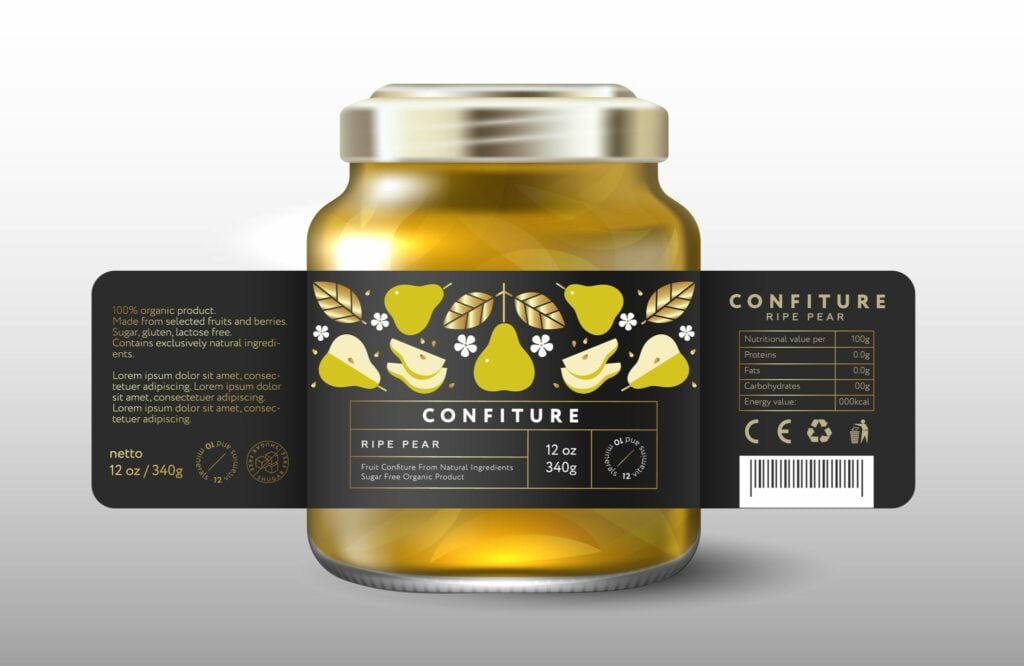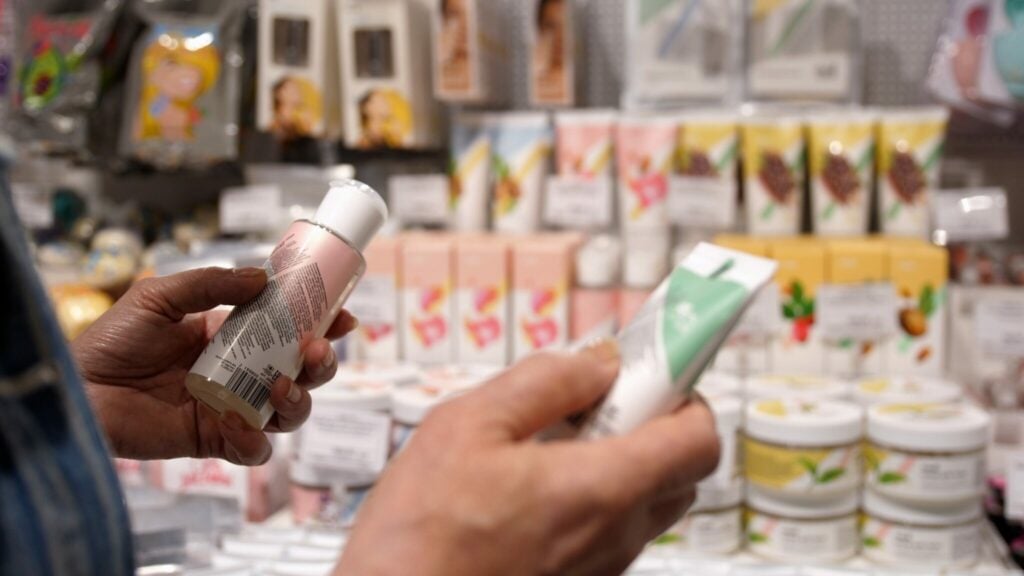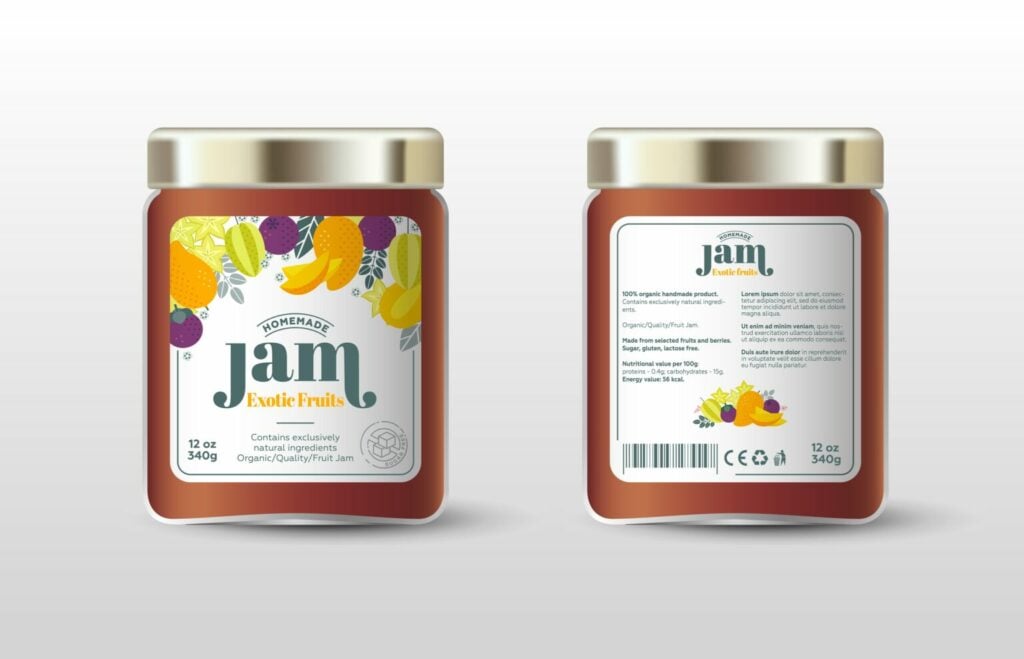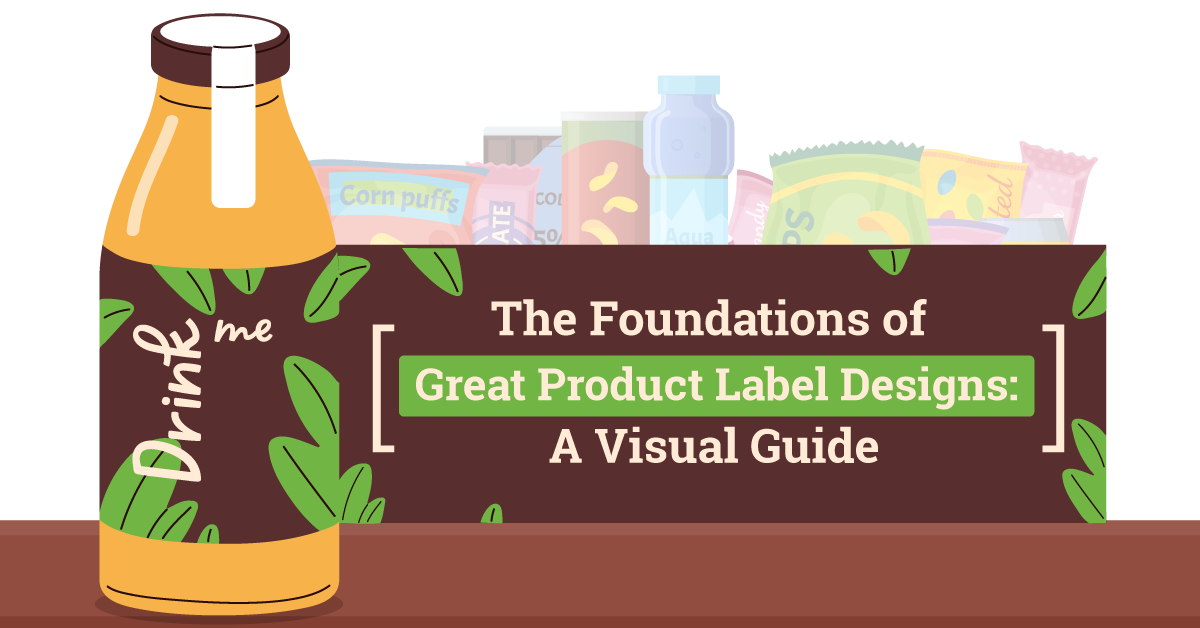The Foundations of Great Product Label Designs: A Visual Guide
Showcasing eye-catching product labels is one way a company can convince a customer to purchase on the spot. Some factors that make up a great label are colors, typography, and product information.
Colors influence around 90% of an initial impression, with 93% of customers focusing on visual appearances when purchasing a product. That means it is essential to have a great product label design.
Poorly designed labels negatively affect a customer’s perception of the brand, leading to short sales. Following certain design principles for a label helps attract the right audience to the brand. This guide provides helpful tips on how to design a product label that gives a company its identity.

Anatomy of a Product Label Design
Though product labels across industries vary from each other, they carry similar elements that make up the anatomy of label design, such as:
1. LOGO
The logo is the foundation of the brand’s identity and its introduction to the audience. Not only can its design convey the company’s tone, but the logo can also establish authority among customers once the brand has grown. It should be memorable and stand out from the competition.
2. PRODUCT NAME
The product name is what audiences will call it and is sometimes incorporated into the logo. Many designers place the item’s purpose in its name, though some companies are creative with their naming conventions. Some examples of product names are Dropbox, Post-it, and Sharpie.
3. PRODUCT DESCRIPTION
Usually printed in smaller text, the product description tells the customer exactly what the product is, such as “cereal,” “shampoo,” or “health supplements.” If the customer did not get the item’s purpose from the product name, they should tell from its description.
4. CAPACITY
Every product has a capacity or size attached to it, which tells the customer the amount of product they are purchasing. These could range from the number of servings, pieces, fluid ounces, and liters. Many companies put both metric and imperial unit measurements on the label.
5. REGULATIONS
Depending on the industry, the label must include instructions, warnings, or expiration dates as mandated by the government. For instance, the Food and Drug Administration (FDA) requires all food products to have a complete list of ingredients, expiration dates, and allergen information on the label.
6. COMPANY INFORMATION
Customers should be able to contact a company if they have concerns or inquiries about the product. It is essential to include both the distributor’s and manufacturer’s names and addresses on the label. Some government organizations, such as the Occupational Safety and Health Administration (OSHA), require this for those reasons and traceability.
If a company is both the manufacturer and distributor, then the product manager can include only one name and address on the label. However, if a company is only the distributor and has a co-packer, the label should have the information of all entities.
7. BARCODE
The barcode stores the product’s information, which makes it easier to get the item through checkout. It is important if a company distributes its products to different retailers since it also helps keep track of inventory and sales.
There are two types of barcodes, the Universal Product Code (UPC) and the International/European Article Number (EAN). The United States mainly uses the UPC, while the worldwide barcode is the EAN.
HOW TO DESIGN PRODUCT LABELS: 8 SIMPLE STEPS

Here are the steps one can reference when designing a product label.
1. KNOW THE CLIENT’S PREFERENCES
If a designer creates a label for a client, they should take note of the client’s preferences. The process usually involves several iterations, so the designer should have several product label design ideas.
Consider asking if the client already has a company logo because they may want this integrated into the label. Otherwise, the designer may need to create a new logo. Another question the client can ask is where they plan to sell the product. If they plan to sell the item in the store, the designer must consider the other things on the shelves to make the label stand out.
2. DETERMINE THE PROPER DIMENSIONS AND SIZE
The label’s dimensions and size depend on the packaging’s size and shape. Products come in all kinds of packaging, so the label must complement the story the item tells. The label should fit neatly on the packaging without overpowering it.
3. DETERMINE PACKAGING MATERIAL
Not only should the label match the size of the packaging, but it should also complement its material. The label helps express the brand’s overall message and must be practical. For instance, clear labels are used for glass and plastic bottles to let customers see the contents inside. The labels must be waterproof if the client sells bath and body products.
4. ARRANGE ALL INFORMATION
A label should grab a customer’s attention and convey essential information. The first elements they should see are the logo and product name. The designer then must decide how to arrange the other information on the label, such as product description, capacity, or ingredients.
5. SELECT COLORS
Colors play a great role in selling the product, so choose combinations carefully. Several factors influence color choice, such as the target audience, the type of product, and what colors competitors are using.
As previously mentioned, colors influence 90% of a customer’s initial impression, which makes it essential that a label stands out. If competitors use similar colors, the designer can pick another set of combinations to distinguish the product from the rest when it sits on the shelves.
6. SELECT TYPOGRAPHY
Font choice plays another role in good label design. A designer pairs typographies to convey information and inform the customer of the product’s importance. A label using different typographies should be both legible and memorable because anyone walking by the shelves should spot the product immediately and be able to read it.
A designer can either use existing font options or create their lettering.
7. SELECT GRAPHICS
Graphics add to the mood and feel of a product while also providing the customer with additional information. For instance, a luxury brand can add repeating patterns and shapes to give its label a minimalist yet sleek look. Likewise, graphics of flowers tell the customer about a shampoo’s scent, while a new cleaning tool can show the customer images of its use.
8. ENSURE THE CLIENT IS INVOLVED
If a designer creates a label for a client, they must keep the client updated with the work. That way, the client provides feedback before the designer makes important changes to the label design or compromises regarding the client’s preferences.
PRODUCT LABEL DESIGN IDEAS: THE DOS AND DON’TS

Here are the dos and don’ts when designing product packaging and labels.
DO
1. INCLUDE ESSENTIAL INFORMATION AND DETAILS
The designer should include the product’s name, the brand’s contact details, the product description, and other required regulations on the label.
2. OPTIMIZE THE DESIGN
Too many elements on a label render it illegible. The simpler the design, the better. One should consider the colors to use, the size, and the position. If the packaging for the product is small, the product name and the logo should still be readable.
Another factor to consider is where the item sits on the shelf. If the store shelf has a small barrier to prevent products from falling, the designer should position the label a little higher to ensure crucial information is still visible.
3. PAIR TYPOGRAPHIES
Different typographies on the label tell different pieces of information. Two dissimilar types of font make a product look more elaborate, while those that complement each other make it look more minimalist.
4. CONSIDER THE AUDIENCE PURCHASING THE PRODUCT
The audience purchasing the product highly influences the design of the label. For instance, a product aimed at children, such as a toy or candy, has more colorful labels with graphics featuring cartoon characters.
On the other hand, a product for adults, such as a luxury wine bottle, tends to have more straightforward labels, with one to two colors and graphics of grapes or vines.
5. PUT ENOUGH BLANK OR WHITE SPACES
White or blank spaces on a label help break up the different information for the customer. Just enough empty areas make the name and details legible. More spaces make the label look austere and calm, though the designer should consider if too much will make it look sparse.
DON’T
1. OVER-CLAIM OR MAKE UNSUPPORTED CLAIMS
A company that includes false, unsupported, or exaggerated claims adversely affects its reputation and credibility. Customers are 90% more likely to buy from a brand recommended by a friend, and word will spread if a product is ineffective or harmful to one’s health.
Some government organizations, such as the FDA, must approve food and health products with claims; otherwise, a company cannot place them on the label.
2. GO OFF-BRAND
One may have free reign over the label’s design but should not go off-brand. If a company has several products, the designer must ensure that the brands have logos, similar colors, and other design elements.
Similarities between labels, even if the products are different, tell customers they belong to the same brand.
3. HAVE TOO MUCH CONTENT
A label with too much content overwhelms a customer and makes the label illegible. Customers may lose interest in purchasing a product with too much information and design elements. If customers want information, keep only crucial details on the label and possibly include a link to the company’s website.
4. JUST FOLLOW TRENDS
As brands try new ways to grab their audience’s attention, many trends have come and gone. In the past years, companies played around with muted color palettes, changed their logos, or used bolder graphics. However, just because these worked for others does not mean they will work for everyone.
Trends will keep changing, and merely following them costs a lot of money and time for a brand. The important thing for a designer is to ensure the label stands out and expresses the brand’s message.
5. JUST GO WITH ANY PRINTING COMPANY
There are many printing companies available on the market. However, one should not partner with the first company they find as they may be unable to print the designer’s specifications. Instead, the designer should speak to several companies, compare quotes, and find their turnaround time and the types of labels they print.
STRATEGIES FOR CREATING A GREAT PRODUCT LABEL DESIGN

Here are the strategies for creating a great product label design.
1. MAKE IT READABLE
The label should be legible for different kinds of customers across age groups. Anyone who passes by the shelf should be able to read what the product is and what it does.
2. UTILIZE THE EMPTY SPACES
One should use empty spaces to break up information. Customers will have difficulty finding the data they need when everything is cluttered.
3. HAVE A CONSISTENT LOGO
With a company logo, the label can reflect the brand. If a designer keeps changing the logo design, it could confuse customers.
4. CONSIDER THE PACKAGING
The size and shape of the packaging dramatically influence the label design. The packaging and label should complement each other. For instance, squeeze bottles need a label that can bend and warp, then go back into shape.
Poor quality labels negatively impact the brand’s reputation, which could lead to a loss of trust.
5. HAVE A DECORATIVE COMPONENT
It gives the product a certain feel and aesthetic that tells the customer more about it. These include different types of graphics, fonts, and colors.
SIMPLE AND CLEAN IS THE WAY
Designing a label can be difficult for a designer. Several factors influence its design, and one must consider a client’s preferences and government regulations. However, a great label enhances a product’s marketability through its first impressions.
Meyers has experts who assist with professional printing solutions for any labeling needs and packaging solutions. Contact Meyers today at Meyers.com.

